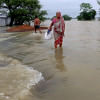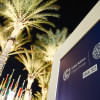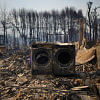Living in a furnace: Is there any way to beat the heat?

Stepping outside in Dhaka these days feels like venturing into a furnace. A scorching sun beats down on a city choked by concrete, and temperatures routinely surpass 35 degrees Celsius—a far cry from the balmy days many of us remember. This relentless heat isn't just uncomfortable; it's a growing public health crisis. Studies by the International Centre for Diarrhoeal Disease Research, Bangladesh (icddr,b) paint a concerning picture: rising temperatures are linked to a surge in heatstroke and dehydration cases, particularly among vulnerable populations like the elderly and children.
The culprit behind this urban inferno is a well-documented phenomenon known as the "urban heat island (UHI)" effect. Dhaka, like many rapidly urbanising cities around the world, has prioritised development at the expense of green spaces. Lush parks and verdant gardens have been replaced by towering buildings and sprawling infrastructure, all constructed from heat-absorbing materials like concrete and asphalt. This transformation has fundamentally altered Dhaka's microclimate. The city now acts like a giant heat sink, absorbing and trapping solar energy throughout the day. With limited vegetation to provide shade and cool the air through evapotranspiration, these heat-soaked surfaces continue to radiate the energy long after sunset, creating a microclimate significantly warmer than surrounding rural areas. This urban heat island effect not only exacerbates the discomfort of daily life but is also overburdening our healthcare system due to heat-related illnesses.
Dhaka's predicament is far from unique. Similar stories of scorching cities are unfolding across the globe. A 2019 study published in the journal Environmental Research Letters found that the UHI effect in Beijing, China, could be as high as 8 degrees Celsius warmer than surrounding areas. This extreme heat contributes to a rise in respiratory problems, with a direct correlation between UHI intensity and hospital admissions for asthma and other respiratory illnesses. In Ahmedabad, India, a 2012 study documented how the UHI effect can raise nighttime temperatures by as much as 7 degrees Celsius compared to rural areas. This dramatic rise in nighttime temperatures translates to a significant increase in energy consumption as residents resort to air conditioners for relief. The overburdened power grids struggle to meet this surge in demand, leading to blackouts and further exacerbating the heat crisis.
The crisis isn't limited to just scorching temperatures. The UHI effect also disrupts natural weather patterns. A 2020 study by the Indian Institute of Technology Delhi found that increased heat island intensity in Delhi led to a decrease in monsoon rainfall by up to 10 percent. This translates to water scarcity, impacting not only residents but also agriculture in surrounding regions, further straining food security. Globally, countries are grappling with the consequences of unchecked urban sprawl and diminishing green spaces. The science is clear: the UHI effect is a real and growing threat to our health and well-being.
Fortunately, there's hope. Cities around the world are implementing effective policies to combat UHIs. We in Dhaka can follow suit with a multi-pronged approach, starting with a greening transformation. Singapore, a global leader in urban sustainability, offers a compelling example with its "City in a Garden" programme. This initiative has demonstrably increased the city's green cover from 30 percent to over 50 percent in recent decades, transforming Singapore into a model metropolis. Imagine Dhaka's bustling boulevards lined with shade trees, parks teeming with greenery, and even vertical gardens adorning buildings. Incentivising residents and businesses to plant trees through tax breaks or subsidies, similar to programmes implemented in cities like Guangzhou, China, can also be a game-changer.
Next, we need to rethink our infrastructure. Policymakers should mandate the use of heat-reflective pavements and rooftops. Los Angeles, US, for instance, has implemented a successful "Cool Pavement" programme that utilises lighter-coloured materials like concrete infused with reflective pigments. These pavements reflect sunlight away from streets, demonstrably reducing surface temperatures by several degrees.
Additionally, public awareness is crucial in this fight. Educational campaigns can inform residents about the dangers of UHIs and empower them to adopt heat-resilient practices. Dhaka can launch a city-wide initiative like "Beat the Heat, Dhaka" to educate residents on ways to stay cool during scorching days. This campaign could include tips on using energy-efficient appliances during off-peak hours, minimising outdoor activity during peak heat hours, and staying hydrated. Furthermore, implementing early warning systems like those in Ahmedabad, India, which utilise SMS alerts to inform vulnerable populations about extreme heat events, can be lifesaving. By equipping residents with the knowledge and resources to combat the heat, we can foster a collective responsibility for creating a cooler and more resilient city.
Dhaka stares down a fiery future, one choked by relentless heat. This isn't just a battle for comfort; it's a fight for the health and well-being of our citizens. By embracing a green revolution, smarter infrastructure, and empowered residents, we can rewrite Dhaka's narrative. Let verdant parks replace concrete jungles, cool pavements temper the sun's fury, and informed citizens become active participants in a cooler future. The time for action is now. Let's turn Dhaka's scorching reality into one where every resident can thrive, not just survive. The choice is ours.
Nahian Rahman is research associate, Bangladesh Institute of Governance and Management (BIGM).
Views expressed in this article are the author's own.
Follow The Daily Star Opinion on Facebook for the latest opinions, commentaries and analyses by experts and professionals. To contribute your article or letter to The Daily Star Opinion, see our guidelines for submission.

 For all latest news, follow The Daily Star's Google News channel.
For all latest news, follow The Daily Star's Google News channel. 











Comments